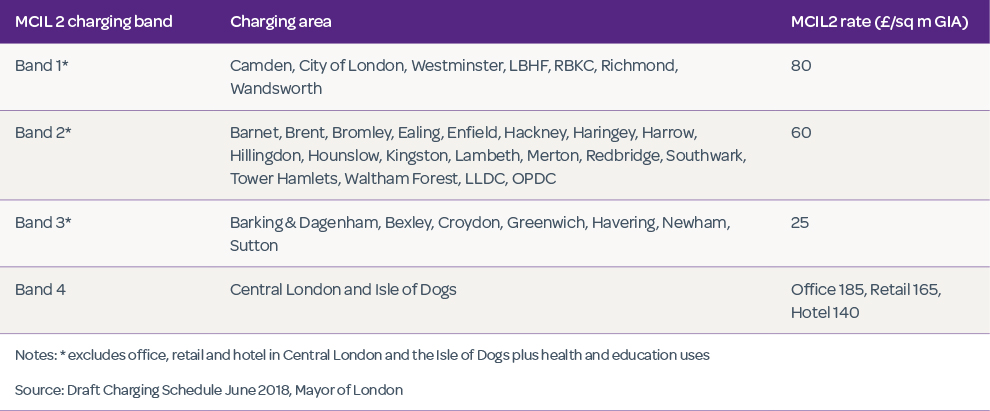Comment
Funding Crossrail 2: Mayor of London’s Community Infrastructure Levy 2
The Mayor of London’s revised Community Infrastructure Levy (MCIL 2) will come into force on 1 April, following the positive examiner’s report released in late 2018. MCIL 2 will replace the current Mayoral CIL (MCIL 1).
MCIL 2 is anticipated to fund approximately 15-20% of the cost of Crossrail 2. Whilst there remains no formal Government approval for Crossrail 2, it has been endorsed by the Secretary of State for Transport and the National Infrastructure Commission, which recommended that Crossrail 2 be taken forward as a priority, with the aim of opening in 2033. If Crossrail 2 does not proceed, funds raised by MCIL 2 would be used for other infrastructure projects identified within the London Plan.
MCIL 2 is levied across four different geographical zones, referred to as bands 1-4. Bands 1-3 cover the boroughs plus the London Legacy Development Corporation (LLDC) and Old Oak and Park Royal Development Corporation (OPDC) but excluding office, retail and hotel development in the defined Central London and the Isle of Dogs areas, which are covered by band 4. This is summarised in the table below.

The only significant modification, required by the Inspector, to the Mayor’s proposals for MCIL 2 is the removal of the Elephant and Castle Opportunity Area from the Central London charging area for office, retail and hotel development (i.e. band 4).
There are a number of borough changes to note: Greenwich moves from Band 2 to Band 3. Waltham Forest and Enfield move from Band 3 to Band 2.
In relation to the current Mayoral CIL charge, whilst the rates of £50, £35 and £20 for bands 1, 2 and 3 are lower than the proposed MICL 2 charges, when projected indexation is applied up to Q2 2019, it is estimated that MCIL 1 charges are equivalent to £65, £46 and £26 for bands 1-3 respectively. Thus the band 1 rate would increase by 23%, the band 2 rate by 31%, and the band 3 rate would be 4% lower.
With regards to the Section 106 Crossrail contribution currently applying o the Central London and Isle of Dogs areas, and also those ‘rest of London’ sites within 1km of Crossrail 1 stations, MCIL 2 will replace the Section 106 requirement entirely.
Implications for schemes in 2019
Any planning application determined before the 1 April 2019 will still be liable for MCIL 1. Any scheme determined on or after this date will be liable for MCIL 2. Therefore, the viability implications of MCIL 2 should be modelled for any schemes submitted this year, unless determination prior to the 1 April is certain.
Those schemes likely to be determined prior to April, but subject to potentially protracted post-committee negotiations e.g. around planning obligations, will need to be managed accordingly.
In addition, several London Boroughs are now also reviewing their own Charging Schedules (e.g. LB Redbridge and Tower Hamlets), with proposed increased rates, and others can be expected to follow over the course of 2019. As a result, landowners and developers will need to be aware of the prospect of further increased CIL costs arising from both MCIL 2 and at the Borough level when acquiring land or redeveloping existing assets.
Contact Oliver Jefferson or Matthew Spilsbury for more information on how MCIL 2 and borough level CIL charges could affect your site and for advice regarding how to mitigate exposure.
8 January 2019